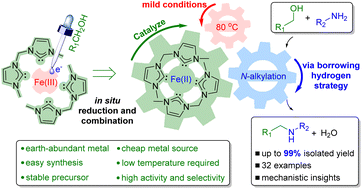Disarming the alkoxide trap to access a practical FeCl3 system for borrowing-hydrogen N-alkylation†
Abstract
Borrowing hydrogen N-alkylation is one of the most valuable transformations in organic synthesis, with high selectivity and atomic economy. The general non-noble metal catalysts for borrowing hydrogen usually have limitations on operational convenience or catalytic efficiency. In particular, the development of practical and mild Fe(III) catalysis is a big challenge due to the alkoxide trap in terms of d-wall issues. Inspired by the theoretical design, utilizing an in situ reaction strategy to overcome the alkoxide trap of Fe(III), we present here a practical in situ ferric chloride and bis-(N-heterocyclic carbene) (bis-NHC) system for the borrowing-hydrogen N-alkylation of amines by alcohols under mild reaction conditions, attributed to the merits of bis-NHC in strong-field ligands, strong σ-donation and π-back-donation, and the trans effect. This system was applied to a wide range of alcohols and amines. Through comprehensive experiments and DFT calculations, the mechanism of the reaction was studied, which highlighted the roles of strong-field ligands, strong σ-donation and π-back-donation, and the trans effect by bis-NHC in ensuring the in situ reduction of Fe(III) to Fe(II) and triggering the borrowing of hydrogen under mild conditions.

- This article is part of the themed collection: 2022 Organic Chemistry Frontiers HOT articles


 Please wait while we load your content...
Please wait while we load your content...